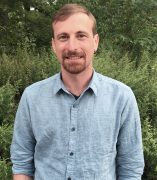Affiliation: University of Illinois Chicago

Andrew Finegold is Assistant Professor of Art History with the University of Illinois Chicago. He holds his degrees from Columbia University (Ph.D., M.Phil., and M.A.) and the University of Houston (B.A.), and his area of specialization is the visual culture of the ancient Americas. His current publication projects include Vital Voids: Cavities and Holes in Mesoamerican Material Culture (2021), and The Temporalitites of Art in Mesoamerica (manuscript in progress).
Anchored by the close analysis of a single object—a Late Classic Maya codex-style dish known as the Resurrection Plate—this talk examines a variety of empty spaces created in diverse grounds in the material culture of ancient Mesoamerica. It is argued that these collectively reflect a fundamental metaphysical conception held by Mesoamerican peoples of holes and voids as necessary prerequisites for the emergence of life and its associated creative energies and material abundance. With iconography that appears to have anticipated the hole that was eventually drilled through its center as part of a regionally prevalent funerary practice by creating imagery that, the planned interaction of the imagery with this hole in the Resurrection Plate evokes a variety of beliefs and practices related to the act of perforation that were broadly shared across Mesoamerica. These include the breaking open of the earth to release its agricultural abundance, the drilling of fire, and the piercing of human flesh. Taken together, these associations serve to demonstrate the consistent, widespread, and transmedial experience of voids as fecund nodes of generative potential.
The painted bowls of the Mimbres culture (c. 1000–1130 CE) provide a uniquely expansive iconographic record for the American Southwest. In the absence of a closely associated textual record, their imagery has often been interpreted through accounts originating from geographically or temporally removed cultures, a problematic approach that merits critique. Although an iconological understanding of the images might not be possible, a phenomenological account has the potential to illuminate other important aspects of these bowls. In this regard, it is argued that some Mimbres painted bowls self-referentially draw attention to the conditions of their own apprehension.
In ancient Mesoamerica, the human body was regularly adorned with finely crafted ornaments. These were often made of highly valued and symbolically charged materials that manifested a cluster of interrelated ideas connected to creative energies and natural fecundity. Much recent scholarly attention has been given to materials from which Mesoamerican jewelry was made, including their particular qualities, attributes, and place within the indigenous worldview. This talk takes a complementary approach to such studies by considering the material and ontological implications of the way some ornaments were articulated with the human body: the piercing of the flesh. In addition to creating spaces to accommodate jewels, the perforation of the body was an activity that carried social significance, most notably in the form of auto-sacrificial bloodletting, but also in rituals that accompanied coming-of-age ceremonies and accession rites. It is argued that all such interventions into the human body should be viewed as a continuum of related behaviors and that holes made within the flesh served as a conduit for the flow of life and vitality. Placed within them, ornaments did more than merely indicate the wearer’s status. They drew attention toward, alluded to, and made tangible and permanent the vital potency of the somatic voids they occupied, and, by extension, the charisma of the bodies that hosted them.